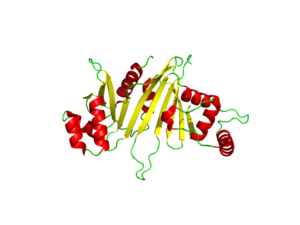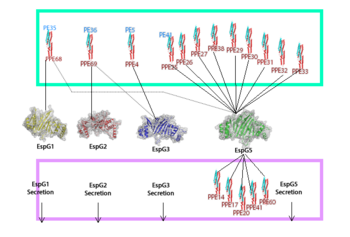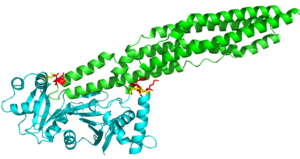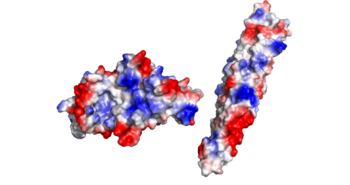Sandbox Reserved 1075
From Proteopedia
(Difference between revisions)
| Line 6: | Line 6: | ||
[[Image:EspG3_White.png|300 px|left|thumb|[http://proteopedia.org/wiki/index.php/4w4i "EspG3 protein"]]] | [[Image:EspG3_White.png|300 px|left|thumb|[http://proteopedia.org/wiki/index.php/4w4i "EspG3 protein"]]] | ||
| + | |||
== General Structure and Function == | == General Structure and Function == | ||
| Line 18: | Line 19: | ||
Here are the key differences found on the tertiary structure of EspG3 (yellow) with EspG5(blue). The highlighted alpha helix shows a difference in length between EspG3 and EspG5. This difference in length contributes to the steric hinderance when binding to a PE-PPE ligand. The random loop highlighted toward the bottom of this protein varies in length between EspG proteins, this influences binding. The small random turn highlighted shows inconceivable difference to the EspG5 protein. The β-2, β-3 sequence similarity between EspG5 and EspG3 is very low. | Here are the key differences found on the tertiary structure of EspG3 (yellow) with EspG5(blue). The highlighted alpha helix shows a difference in length between EspG3 and EspG5. This difference in length contributes to the steric hinderance when binding to a PE-PPE ligand. The random loop highlighted toward the bottom of this protein varies in length between EspG proteins, this influences binding. The small random turn highlighted shows inconceivable difference to the EspG5 protein. The β-2, β-3 sequence similarity between EspG5 and EspG3 is very low. | ||
| + | |||
== Excretion == | == Excretion == | ||
| Line 28: | Line 30: | ||
== Binding == | == Binding == | ||
The EspG-PE-PPE binding is highly specific. The specific pair we were looking at was the EspG5-PE25-PPE41 complex. A variety of binding factors influence the EspG that will bind to a specific PE-PPE. The secretion pathway carried out needs the coupled protein. | The EspG-PE-PPE binding is highly specific. The specific pair we were looking at was the EspG5-PE25-PPE41 complex. A variety of binding factors influence the EspG that will bind to a specific PE-PPE. The secretion pathway carried out needs the coupled protein. | ||
| - | |||
'''Residue Interactions:''' | '''Residue Interactions:''' | ||
| Line 42: | Line 43: | ||
<scene name='69/694242/Espg5_surface_with_pe-ppe/1'>EspG5 Concavity with PE-PPE bound</scene> | <scene name='69/694242/Espg5_surface_with_pe-ppe/1'>EspG5 Concavity with PE-PPE bound</scene> | ||
The concave region on the C-terminal half of the EspG protein facilitates binding of the tip of the cigar shaped PE-PPE. The tight bind between the protein and ligand works with the hydrophobic effect to increase binding affinity for the specific EspG-PE-PPE complex. These hydrophobic regions are buried after the binding of PE-PPE to EspG, which exemplifies to the hydrophobic effect due to the increase in entropy of water. | The concave region on the C-terminal half of the EspG protein facilitates binding of the tip of the cigar shaped PE-PPE. The tight bind between the protein and ligand works with the hydrophobic effect to increase binding affinity for the specific EspG-PE-PPE complex. These hydrophobic regions are buried after the binding of PE-PPE to EspG, which exemplifies to the hydrophobic effect due to the increase in entropy of water. | ||
| - | |||
| Line 52: | Line 52: | ||
'''Electrostatics:''' | '''Electrostatics:''' | ||
There is an overall negative charge on the PE-PPE complex, and the binding tip is only partially negative. On the EspG5 protein, the binding pocket is partially positive, which aids coupling of the EspG & PE-PPE complex. The other EspG proteins found in 'Mycobacterium tuberculosis' have different electrostatic pocket charges which prevent binding of the PE25-PPE41 ligand. | There is an overall negative charge on the PE-PPE complex, and the binding tip is only partially negative. On the EspG5 protein, the binding pocket is partially positive, which aids coupling of the EspG & PE-PPE complex. The other EspG proteins found in 'Mycobacterium tuberculosis' have different electrostatic pocket charges which prevent binding of the PE25-PPE41 ligand. | ||
| - | |||
[[Image:EspG5_Electrostatics_W.png|350 px|left|thumb|Electrostatics]] | [[Image:EspG5_Electrostatics_W.png|350 px|left|thumb|Electrostatics]] | ||
Revision as of 01:05, 16 April 2015
| |||||||||||
References
- ↑ Ekiert DC, Cox JS. Structure of a PE-PPE-EspG complex from Mycobacterium tuberculosis reveals molecular specificity of ESX protein secretion. Proc Natl Acad Sci U S A. 2014 Oct 14;111(41):14758-63. doi:, 10.1073/pnas.1409345111. Epub 2014 Oct 1. PMID:25275011 doi:http://dx.doi.org/10.1073/pnas.1409345111
- ↑ Renshaw PS, Lightbody KL, Veverka V, Muskett FW, Kelly G, Frenkiel TA, Gordon SV, Hewinson RG, Burke B, Norman J, Williamson RA, Carr MD. Structure and function of the complex formed by the tuberculosis virulence factors CFP-10 and ESAT-6. EMBO J. 2005 Jul 20;24(14):2491-8. Epub 2005 Jun 23. PMID:15973432
- ↑ Ekiert DC, Cox JS. Structure of a PE-PPE-EspG complex from Mycobacterium tuberculosis reveals molecular specificity of ESX protein secretion. Proc Natl Acad Sci U S A. 2014 Oct 14;111(41):14758-63. doi:, 10.1073/pnas.1409345111. Epub 2014 Oct 1. PMID:25275011 doi:http://dx.doi.org/10.1073/pnas.1409345111
Similar Pages
Student Contributors
- Mark Meredith
- Jonathan Golliher





